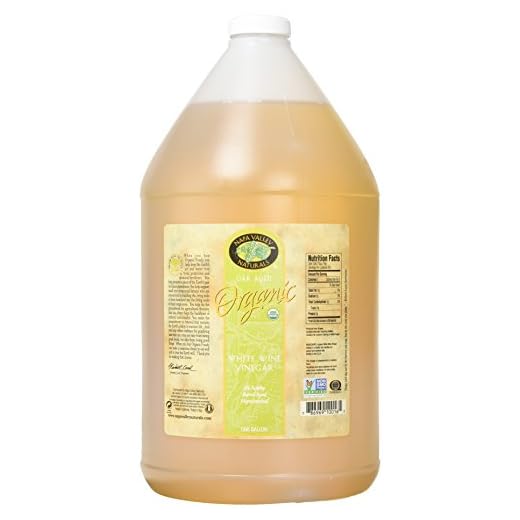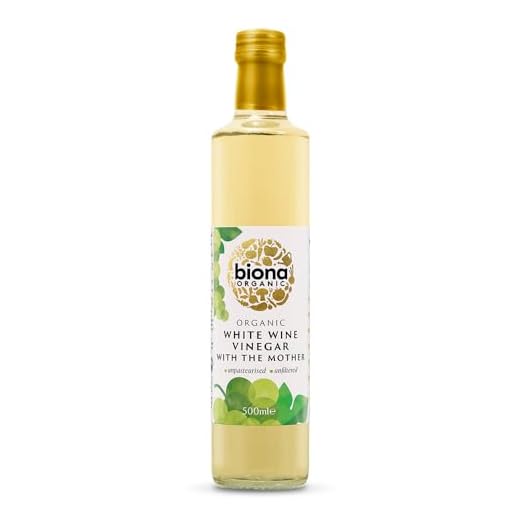

Yes, this product is suitable for those avoiding grains. It is made from fermented grapes, ensuring that it does not contain any components derived from gluten-containing cereals. For those with sensitivities, it’s a safe choice for dressings, marinades, and various culinary applications.
When selecting a brand, always check the label. While the base ingredient is naturally devoid of grains, cross-contamination can occur during processing. It’s wise to look for certifications or statements confirming that the product is free from gluten contamination.
This option brings a tangy flavor profile to dishes without the worry associated with gluten. In my experience, it pairs wonderfully with salads and seafood, enhancing the overall taste without compromising dietary restrictions. Enjoy experimenting with this versatile ingredient!
Is White Wine Vinegar Gluten Free
Yes, this type of acid produced from fermented grape juice is suitable for those avoiding proteins found in wheat and similar grains. The fermentation process generally eliminates any trace of such proteins, making it a safe choice for individuals with sensitivities.
When selecting this acidic condiment, it’s wise to check the label for any additives or flavorings that might introduce gluten. Pure versions made from grapes are typically safe, but some brands could incorporate other ingredients that may not be suitable.
For culinary applications, this liquid can enhance dishes without compromising dietary restrictions. Whether used in dressings, marinades, or sauces, it provides a tangy flavor that complements various ingredients without the risk associated with gluten.
Here’s a simple comparison of common acidic options:
| Type | Gluten Status |
|---|---|
| Apple Cider | Safe |
| Balsamic | Safe (check for additives) |
| Rice | Safe |
| Distilled White | Safe |
For those with dietary restrictions, opting for a brand that clearly labels its products as devoid of any gluten-containing ingredients is advisable. This way, you can enjoy culinary creations without concern.
Understanding Ingredients of This Condiment
To determine the safety of this condiment for those avoiding certain proteins, it’s vital to understand its composition. Typically, this liquid is made from fermented grapes, which are naturally free from those unwanted proteins. The fermentation process converts the sugars in grapes into acetic acid, resulting in a tangy flavor profile.
Main Components
- Base Ingredients: Primarily derived from various grape varieties, ensuring a rich taste.
- Acetic Acid: The main active component responsible for its characteristic sharpness.
- Water: Often added to adjust acidity and enhance flavor balance.
Potential Additives
While the primary components are straightforward, some brands may include additional ingredients for flavor enhancement. Always check labels for:
- Flavorings: Some manufacturers might introduce herbs or spices.
- Preservatives: Certain brands could add stabilizers which should be scrutinized.
For anyone with dietary restrictions, it’s prudent to read labels carefully. Opting for organic or artisanal brands can often mean fewer additives and a more natural product. This approach typically aligns with health-conscious choices.
How White Wine Vinegar is Made
The production of this tangy liquid involves a two-step fermentation process. Initially, the primary ingredient, which is fermented grape juice, undergoes alcoholic fermentation. Yeast converts the sugars in the juice into alcohol, resulting in a base product similar to wine.
Step 1: Alcoholic Fermentation
- Select high-quality grapes, preferably those with a balanced sugar and acid level.
- Crush the grapes and extract the juice.
- Introduce yeast to the juice to start fermentation, typically lasting several weeks.
- Monitor temperature and sugar levels to ensure optimal fermentation conditions.
Step 2: Acetic Acid Fermentation
- Once fermentation is complete, the alcoholic liquid is exposed to oxygen.
- Acetic acid bacteria, naturally present in the environment, convert alcohol into acetic acid.
- This process can take anywhere from a few weeks to several months, depending on desired acidity levels.
- Flavor profiles can be enhanced by aging in wooden barrels, which adds complexity.
After fermentation is completed, the final product is filtered and bottled. This versatile ingredient can elevate dishes and dressings, like in how to cook lamb cutlets, enhancing flavors and offering a zesty finish.
Cross-Contamination Risks in Production
Manufacturers must prioritize cleanliness and safety during the production of any liquid derived from fermented ingredients. Cross-contamination poses a significant risk, particularly for individuals with specific dietary restrictions. It’s crucial to verify that the facility where the item is processed adheres to rigorous sanitation protocols and maintains dedicated equipment for different types of products.
Facility Standards
Look for producers that provide transparency regarding their production practices. Facilities should ideally be certified for allergen control, indicating that they implement measures to prevent cross-contact with other substances. This includes thorough cleaning of machinery and surfaces between batches. If possible, inquire whether separate storage areas are used for raw materials to further minimize risk.
Labeling and Certifications
Always check labeling for any allergen warnings or certifications related to gluten. Some brands highlight their commitment to avoiding cross-contact on their labels, which can provide peace of mind. If a product lacks this information, contacting the manufacturer for clarification can be beneficial. This proactive approach helps ensure that you make informed choices that align with your dietary needs.
Labeling and Certification for Gluten-Free Products
Always check for certifications indicating the absence of problematic proteins. Look for labels stating “certified gluten-free,” which ensures that the product meets strict guidelines. This certification typically involves rigorous testing to verify that the item contains less than 20 parts per million of the troublesome substance.
In addition to certification, scrutinize the ingredient list for any potential allergens. Ingredients like malt or other grain-derived additives can signal hidden risks. Transparency in labeling is crucial; brands committed to safety often provide detailed information about sourcing and production practices.
Familiarize yourself with different certification organizations, as their standards may vary. Some reputable entities include the Gluten-Free Certification Organization (GFCO) and the Celiac Support Association (CSA). These organizations maintain stringent protocols to ensure product integrity, providing peace of mind for consumers.
Be cautious with products labeled as “natural” or “organic,” as these terms do not guarantee safety from cross-contamination. Always verify the presence of a gluten-free certification when selecting items, especially in categories prone to cross-contact during manufacturing.
Educating yourself about labeling and certification can significantly enhance your shopping experience. By prioritizing certified options, you can make informed choices that align with your dietary needs.
Common Uses and Substitutes for White Wine Vinegar
This acid can elevate dishes through its sharpness and subtle flavor. It’s commonly utilized in salad dressings, marinades, and sauces. For vinaigrettes, combining it with olive oil creates a delightful balance, while a splash in sautéed vegetables enhances their taste profile.
Substitutes for This Ingredient
If you’re out of this specific acid, several alternatives can work well. Apple cider vinegar offers a similar tang, while rice vinegar provides a milder taste. For a unique twist, consider using lemon juice, which adds brightness. If you’re seeking a more robust flavor, balsamic vinegar can also serve as a substitute, though it brings a sweeter profile.
Cooking Techniques
In cooking, a bit of this acidic liquid can brighten soups and stews, cutting through richness and adding depth. It’s also effective in pickling, offering a crisp finish to vegetables. When deglazing a pan, it can lift caramelized bits, enriching sauces with added complexity.
Expert Opinions on Gluten Content in Vinegar
Experts agree that most fermented liquids, including those derived from grapes, are devoid of any harmful proteins. The fermentation process typically transforms any potential gluten into non-reactive compounds, making these liquids suitable for those with sensitivities.
Renowned food scientists emphasize that the acetic acid fermentation process effectively eliminates any traces of cereal grains. This is particularly true for those vinegars made from fruits or grains that undergo complete fermentation. According to a study by the American Institute for Cancer Research, the final product is generally safe for individuals concerned about gluten intake.
It is crucial, however, to scrutinize labels. Some manufacturers may introduce additives or flavorings that could contain gluten. Consulting with producers or researching specific brands can ensure the absence of unwanted allergens. Experts recommend choosing products that carry a certification to guarantee the absence of any problematic ingredients.
Through careful selection and awareness, those with dietary restrictions can confidently incorporate these culinary staples into their diets without fear of adverse reactions. Always consult with a healthcare professional if unsure about specific products.
FAQ:
Is white wine vinegar gluten free?
Yes, white wine vinegar is gluten free. It is made from fermented white wine, which does not contain gluten. However, it is always a good idea to check the label for any potential cross-contamination or additives that might contain gluten.
Can people with celiac disease use white wine vinegar?
Yes, individuals with celiac disease can safely use white wine vinegar. Since it is derived from wine, which is gluten free, it does not pose a risk for those who are sensitive to gluten. Always read the packaging to ensure there are no additives that may contain gluten.
What should I look for when buying white wine vinegar to ensure it is gluten free?
When purchasing white wine vinegar, check the ingredient list to confirm it only includes wine and acetic acid. Look for labels that specifically state “gluten free” to ensure it meets dietary restrictions. Additionally, be aware of potential cross-contamination in facilities that process gluten-containing products.
Are there any brands of white wine vinegar that are known to be gluten free?
Many brands of white wine vinegar are gluten free, including popular ones like Colavita and Pompeian. However, it’s best to review each brand’s label or their official website for gluten-free certifications. This helps ensure that the product meets your dietary needs without any risk of gluten contamination.







